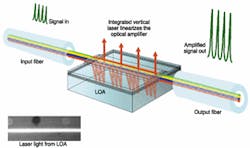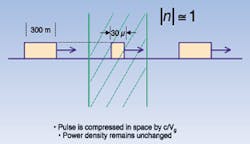Extraordinary efforts yield successful photonics meeting
Despite the fact that the annual affiliates meeting of the Center for Nonlinear Optical Materials (CNOM) at Stanford University (Palo Alto, CA) took place in the midst of an economic downturn and a period of air-travel restrictions just days after the Sept. 11 terror attacks, attendance increased more than 30% over last year's meeting, which was held in the midst of the telecom boom.
About 220 people were registered for this year's meeting, and about 15 registrants from overseas and 30 registrants from within the United States could not attend, according to program director Robert Byer. Several alternative presenters filled in the gaps for presenters who weren't able to make it, however, and a number of registrants made heroic efforts to attend.
"Professor Alan Wilner from USC was in Florida on Tuesday, Sept. 11. So he and his students rented a car and they drove from Florida to attend the meeting," Byer said. "Alan gave his talk at 11:30 in the morning on Friday. Then he and his students got in the car and drove home to Los Angeles. We awarded Alan the 'golden driver' award for the longest distance traveled to attend the meeting."
One of the Saturday speakers, Mohammad Islam, CEO of Xtera (Allen, TX), had no way to get from Texas to California until he learned that a private jet belonging to another company was flying empty (because of a company travel ban) in the direction of the meeting. So Islam hitched a ride on the private jet and arrived in time to give his talk. "There was a lot of effort made to try to get here and attend the meeting," Byer said.
Despite such noteworthy efforts, numerous registrants, including several scheduled speakers, simply were not able to attend. The organizers came up with a revised schedule just prior to the meeting that drew heavily on expertise in photonics from within the Bay Area (see Fig. 1). For instance, the original plenary speaker, Fred Leonberger, senior vice president and CTO of JDS Uniphase (JDSU; Ottawa, Ont., Canada and San Jose, CA), was unable to leave from Connecticut. Instead, Don Scifres, co-chairman and chief strategy officer at JDSU but located in the area, stood in for him with a talk on advances and trends in fiberoptic components and modules. Other local replacement speakers included Asif Godil, CEO of Lightconnect (Newark, CA), a MEMS-switch startup company based on a Stanford technology that is already being implemented in MEMS-based display technology by Silicon Light Machines (Sunnyvale, CA).
Engineering professor Stephen Harris, the scheduled keynote speaker, was local to Stanford, and if there had been a "prize for giving a talk that most people said they'd like to hear about," Harris's talk on slow light would have won it, Byer said. In the context of current work on Bose-condensated cooled atoms and dispersion control within a medium for slowing the group velocity of light to a standstill, Harris basically described a fundamental science experiment that, 20 years from now, might enable information storage on light pulses for time periods on the order of milliseconds (see Fig. 2). "You could think about it in terms of a light communications system: downloading information as light, storing it for some period of time, and releasing it over some later period of time," Byer added. "That opens up a lot of possibilities. So it really resonated with people."The appreciation stirred by Harris' keynote address was also indicative of a key factor that attendees found valuable at the meeting. "A comment from many of the attendees was that they appreciated the time that they could spend listening to some of the very basic and fundamental scientific breakthroughs, because it got them back to thinking long-range again," Byer said. "We can get so locked up in all of the near-term switches, modulators, amplifiers, and other things that we need to build a photonics communications system that we forget there are things 10 and 20 years out that we can think about every once in a while."
Another difference between this year's meeting and last year's was that the CNOM affiliate program has now been incorporated into the Stanford Photonics Research Center, initiated by a $25 million grant from Michael Fitzpatrick, former CEO of ETEK, and his wife. "What we've elected to do at Stanford is to create an affiliate program associated with the Fitzpatrick Photonics Institute," Byer said. A long-term goal is to raise about $125 million to replace the existing CNOM Ginzton Lab on the Stanford campus with a new building for the Photonics Institute.
Student participation also was strong this year in both oral presentations and poster sessions, Byer said. Despite the slow economy, investments in photonics startup companies have not slowed down, and companies are still interested in hiring, he added. "It's just not visible to the public at large."
About the Author
Hassaun A. Jones-Bey
Senior Editor and Freelance Writer
Hassaun A. Jones-Bey was a senior editor and then freelance writer for Laser Focus World.

